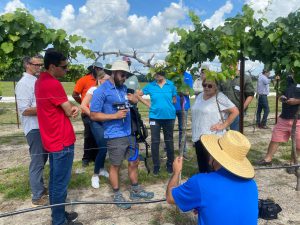Jun 2, 2023Preventing Pierce’s disease in winegrapes: a biological approach
University of Florida Institute of Food and Agricultural Sciences (UF/IFAS) researchers are looking into a biological approach in managing Pierce’s disease in grapes.
On May 18, the Grape Field Day was hosted at the UF/IFAS Plant Research and Education Center in Citra, Florida.
Ali Sarkhosh, assistant professor of UF/IFAS’ Horticultural Sciences, hosted the event.


The event was filled with talks and field activities for hobbyists and commercial grape growers.
In the 1920s, grapes covered the Florida landscape, but Pierce’s disease along with population growth wiped out most of the booming industry. Pierce’s disease is a bacterial infection caused by Xylella fastidiosa that infects the plant xylem and is easily spread throughout the vineyard by insects. The disease causes leaves to wilt, turn yellow and eventually fall off and the fruit to shrivel. Plants that contract Pierce’s disease should be removed from the vineyard at the onset of the symptoms to avoid spreading, according to a news release.
The easiest way to prevent Pierce’s disease is to select disease-resistant grape varieties including Blanc DuBois and Southern Home. Muscadine grapes from American descent (contrary to those of European descent) are generally considered to be resistant and/or tolerant of Pierce’s disease. More about muscadines grown in Florida is available here.
Preventive treatments for Pierce’s disease is being studied. Researchers from A&P Inphatic demonstrated some of the latest technology being used to prevent Pierce’s disease in vineyards. The research involves a bacteriophage (XylPhi-PD) that is injected into the xylem of the plant at the base and at the upper branches that attacks the bacterium. This is an actual virus that is labeled for use in Florida grapes, according to the release. The bacteriophages enter the bacterium, reproduce themselves and eventually kill the bacteria throughout the plant.


A&P works with 30 industrial partners that have adopted the biological treatment approach. To-date, the research trials support the approach as a preventative measure for Pierce’s disease rather than a treatment for vineyards that are already severely impacted, according to the release.
J.R. Newbold III, president of the Florida Wine and Grape Growers Association, was in attendance and is a commercial wine grape grower in Putnam County. He grows approximately 10 acres of muscadine winegrapes and partners with Lakeridge Winery in Clermont, Florida, to commercially harvest grapes for wine production.
Newbold updated the group on how to become a part of the organization that celebrated its 100 year anniversary in January. Although the 2017 USDA Agriculture Statistics reports approximately 1,500 acres of grapes grown in Florida, Newbold estimated that number is now less than 1,000 acres.















